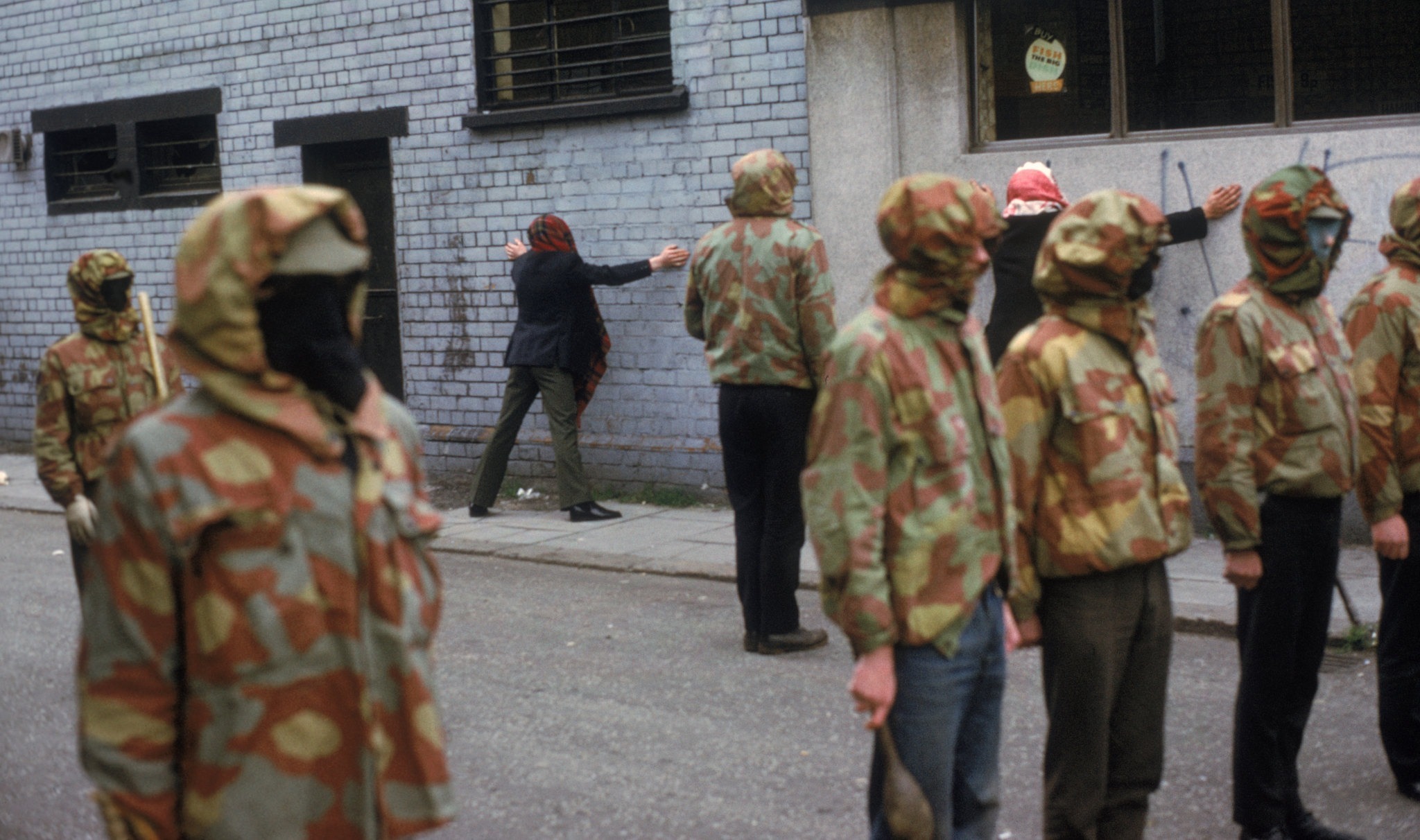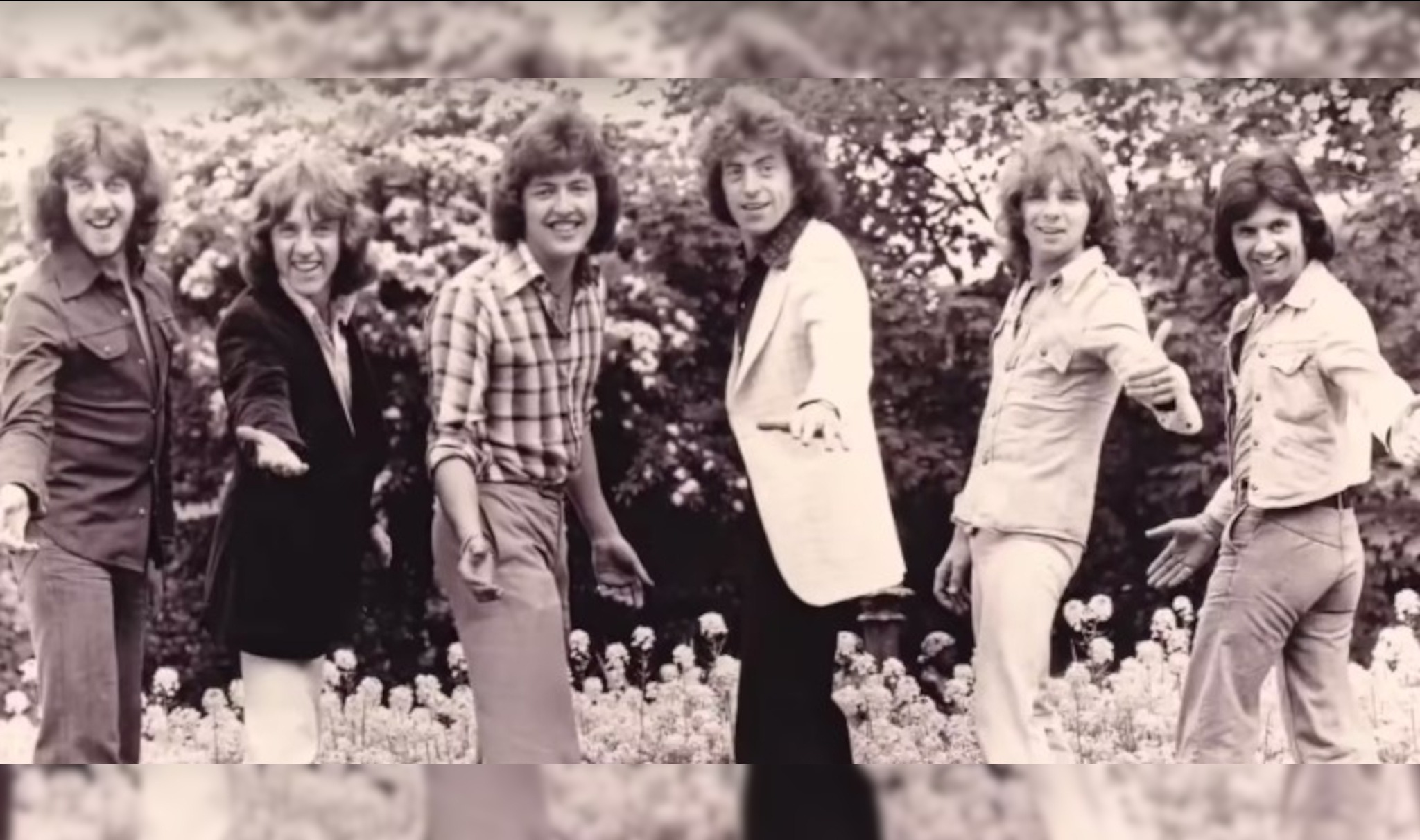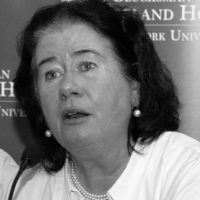A damning Police Ombudsman’s report into 27 murders and attempted murders in Northern Ireland has found that Special Branch officers protected, armed, paid and colluded with at least eight loyalist killers in the early 1990s.
The Royal Ulster Constabulary (RUC), the report said last week, had also deliberately destroyed incriminating evidence and had made “significant” investigative and intelligence failures into a series of sectarian murders in South Belfast.
The report’s author, solicitor now Ombudsman, Marie Anderson, said it was “totally unacceptable” and “unforgivable” that police used informants in the Ulster Defence Association (UDA) whom they knew were engaged in crimes up to and including murder.
These Ombudsman revelations – the latest in a long line of official reports finding collusion between the police and loyalists in Northern Ireland – caused a stir locally last week, but few waves in Britain although successive UK governments were culpable.
What no-one has highlighted is the loyalist organisation responsible – the UDA – was legally-constituted at the time of the murders and that its leadership held regular meetings over the course of three decades with British politicians and senior civil servants.
We know this because although, like Matilda, the British establishment tells such “dreadful lies” it makes “one gasp and stretch one’s eyes” – it sometimes tells itself the truth and, on occasion, even neglects to erase the evidence.
Declassified documents found in the British National Archives show London knew that the UDA, Northern Ireland’s most lethal loyalist group, was carrying out wholesale murder even as ministers defended its legal status.
Explainer
Police Ombudsman: The official watchdog that oversees police conduct in Northern Ireland.
RUC: Royal Ulster Constabulary, the police force responsible for Northern Ireland until 2001.
UDR: Ulster Defence Regiment, a locally-recruited British army infantry unit.
Loyalists: Pro-British paramilitaries, opposing a united Ireland.
UDA: Ulster Defence Association, a loyalist vigilante group, banned as a terrorist group in 1992.
UFF: Ulster Freedom Fighters, a cover name for the UDA.
SDLP: Social Democratic and Labour Party.
IRA: Irish Republican Army, Pro-Irish paramilitaries supporting a united Ireland.
Nom de guerre
The UDA’s alter ego, the Ulster Freedom Fighters (UFF), was proscribed in November 1973 – but the UDA remained a legal organisation until August 1992 – even though the authorities knew it did not exist as a separate entity.
London maintained the polite fiction that the two groups were separate but privately senior officials knew both organisations were the same and that it was intent on sectarian slaughter.
We know this is true because of an internal British assessment, dated 2 September 1976, of the relative strengths of paramilitary groups in Northern Ireland.
The (anonymous) writer stated that the UDA: “either denies responsibility for sectarian murders and terrorist bombings or claims them in the name of the Ulster Freedom Fighters (UFF), a proscribed and essentially fictitious organisation which is widely known to be a nom de guerre of the UDA”.
So, although London knew perfectly well the UDA itself was up to its armpits in blood, the authorities tolerated its legal status throughout the conflict, only proscribing it two years before the loyalist ceasefires.
Meanwhile, successive British governments signaled to the families of its many victims in Northern Ireland and to the outside world that the “good” UDA was not responsible for murder – the “bad” UFF was doing it all.
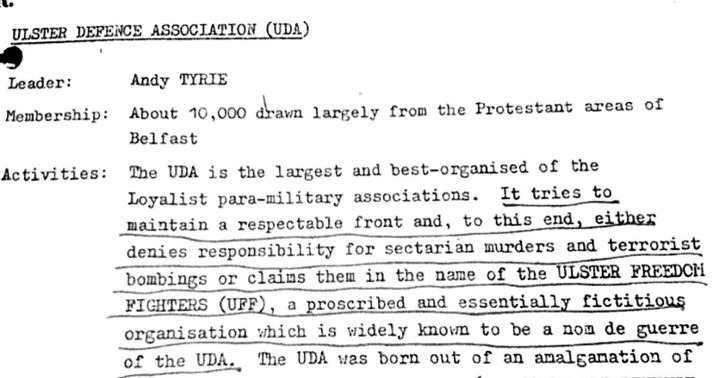
‘Vermin’
The authorities cannot excuse themselves from knowing the sectarian motives of the UDA/UFF. A month after the UFF was (allegedly) formed, a “UFF spokesman” described the murders of SDLP Senator Paddy Wilson and his friend, Irene Andrews, as a “ritual killing” and a “godsend to get rid of vermin like that”.
Thus the leadership of a group responsible for the brutal stabbing to death of an elected politician and his friend, calling them “vermin”, were regularly consulted over many years by senior civil servants and British politicians.
There were repeated appeals to outlaw the UDA from, amongst others, the Irish government, the moderate nationalist SDLP, the Alliance Party and the Catholic Church hierarchy – yet although it killed over 441 people, it remained legal.
On 1 February 1973, for example, John Hume (later SDLP leader) said London could proscribe the UDA under Section 7 (paragraphs 1 and 2) of the Northern Ireland (1951) Public Order Amendment Act but his suggestion was ignored.
Much later, in September 1981, the then leader of the SDLP, Gerry Fitt, demanded the proscription of the UDA after it was believed to have killed Catholic man Eugene Mulholland.
A senior civil servant (one Colin Davenport) first noted that the UDA had denied involvement but then went on to comment, “we have always regarded the existence of such denials as more important than their accuracy”.
This came fully 18 years after a Northern Ireland “Information Policy Unit” meeting, on 19 June 1973, where it was agreed a pattern had emerged of the UDA using the name UFF to claim any atrocity that was particularly horrifying.
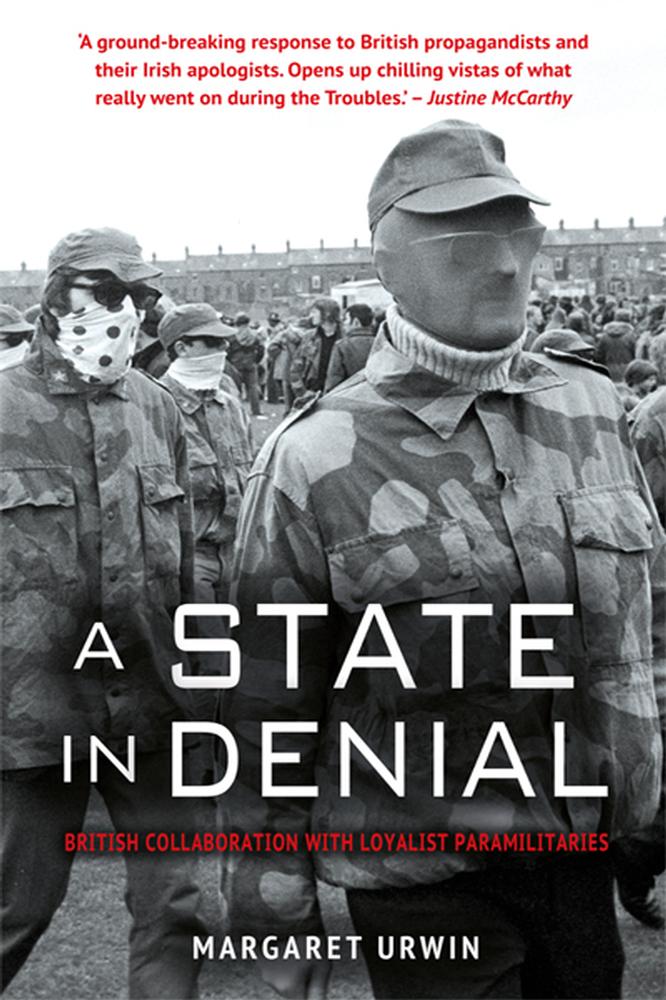
Torture, rape and murder
One such atrocity that can be said to deserve this description took place a year previously. On the night of 11 July 1972, four loyalists smashed their way into the home of widow Sarah McClenaghan in North Belfast where she lived with her disabled 14-year-old son, David, and a Protestant lodger.
They forced the child to fetch his mother’s handbag in which they found a missal and rosary beads, evidence of her religion. Two of the then raped Mrs McClenaghan while a UDA gunman shot her son three times as she tried to shield him.
David McClenaghan died from his injuries while his violated mother was seriously injured. The gang also tortured her lodger by placing a cigarette lighter under his chin although he was spared from death after he produced his Orange sash to prove he was a Protestant.
Shortly before the McClenaghan atrocity, the General Officer Commanding British troops in Northern Ireland, General Sir Harold Tuzo, had met UDA leaders after the breakdown of an IRA ceasefire.
Although, he said, the UDA would build barricades, “indulge in indiscriminate shooting into Catholic areas” and “provoke trouble on the interfaces”, Tuzo recommended toleration for its vigilante-style activities in Protestant areas.
Moreover, said Tuzo, it might be necessary to “turn a blind eye to UDA arms” and enlist the UDA and Orange Volunteers to assist the RUC in securing “their own” areas.
Ulster ‘Defence’ Regiment
Tuzo’s meeting with the UDA in July 1972 was one of dozens of meetings with senior officials where the UDA was invited to give its views. During one such encounter, in August 1974, it demanded the enlargement of the British Army’s Ulster Defence Regiment (UDR).
The UDR was, at this time, already the largest regiment in the British Army and was regularly being criticised by Irish nationalists for its involvement in alleged collusion with loyalist paramilitaries including the UDA.
The previous August (1973) an internal British intelligence assessment called “Subversion in the UDR” was prepared for the Joint Intelligence Committee and Downing Street.
It estimated between 5% and 15% of UDR soldiers were linked to loyalist paramilitaries and that the “best single source of weapons, and the only significant source of modern weapons, for Protestant extremist groups was the UDR”.
In the context of a paramilitary group known to be systematically infiltrating a British Army regiment for lethal and unlawful purposes, it seems strange – to say the least – for senior civil servants to engage with the UDA on the size and role of the UDR whose supposed task was to put them out of business.
The revelations of UDA/UDR collusion continue to come thick and fast. In January, a Police Ombudsman for Northern Ireland report on 19 UDA murders in the north/west of Northern Ireland in the 1980s concluded UDR soldiers had passed intelligence to the UDA, targeting nationalists, and the police had failed to investigate.
‘Not averse to killing Catholics’
The UDA’s position within the law led Andy Tyrie (the UDA’s so-called “Supreme Commander” in the 1980s) to demand a firearms licence. It is unclear this was ever granted but he was advised at a meeting on 21 March 1975 to encourage his own bodyguard to apply.
This was despite the British state’s own internal assessment of Tyrie being “not averse to killing Catholics, even those who have no Republican connections, if he thinks it necessary at any particular point in time.”
In 1972, the year of the greatest loss of life in Northern Ireland, at least 12 UDA men were legally carrying licenced firearms with the then RUC Chief Constable, Sir Graham Shillington, concluding they should not be revoked.
It is not as though the UDA was hiding its motives under a barrel. On 4 November 1980, a telegram from the Foreign and Commonwealth Office to the British Embassy in Washington cited a UDA public statement of 29 October the same year in which it said it would use “Every means at its disposal to eliminate those who pose a threat to the state of Ulster”.
Tragically, those who were “eliminated” by the UDA’s guns were predominantly ordinary Catholic working people who were either killed in their homes or workplaces for no other reason than their faith – while the organisation to which their killers belonged remained perfectly legal.
Perhaps this is one reason why London is so keen to pass an amnesty that would protect retired soldiers and policeman from prosecutions for their involvement in murder during the Troubles.

